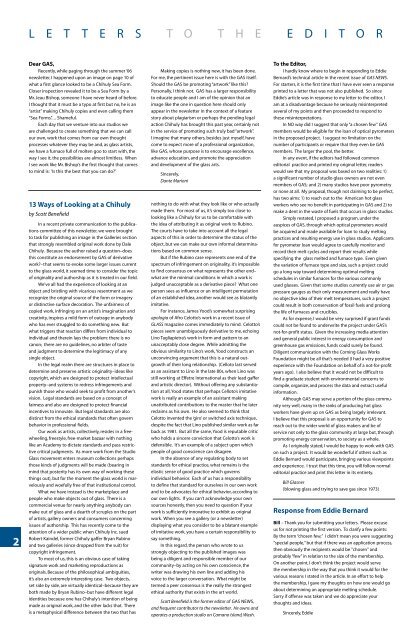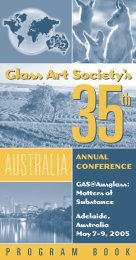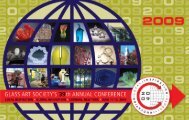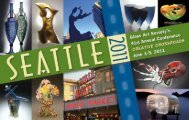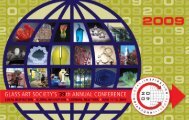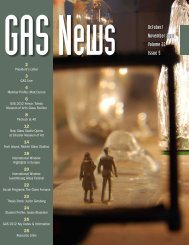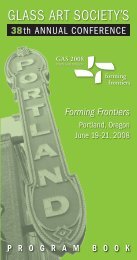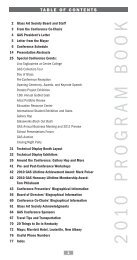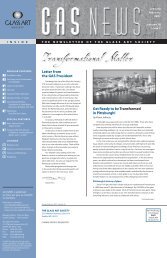GAS News S/O 06 copy - Glass Art Society
GAS News S/O 06 copy - Glass Art Society
GAS News S/O 06 copy - Glass Art Society
You also want an ePaper? Increase the reach of your titles
YUMPU automatically turns print PDFs into web optimized ePapers that Google loves.
L E T T E R S T O T H E E D I T O R<br />
2<br />
Dear <strong>GAS</strong>,<br />
Recently, while paging through the summer ‘<strong>06</strong><br />
newsletter, I happened upon an image on page 10 of<br />
what a first glance looked to be a Chihuly Sea Form.<br />
Closer inspection revealed it to be a Sea Form by a<br />
Mr. Jeau Bishop, someone I have never heard of before.<br />
I thought that it must be a typo at first but no, he is an<br />
“artist” making Chihuly copies and even calling them<br />
“Sea Forms”.... Shameful.<br />
Each day that we venture into our studios we<br />
are challenged to create something that we can call<br />
our own, work that comes from our own thought<br />
processes whatever they may be and, as glass artists,<br />
we have a furnace full of molten goo to start with, the<br />
way I see it, the possibilities are almost limitless. When<br />
I see work like Mr. Bishop’s the first thought that comes<br />
to mind is: ‘Is this the best that you can do?’<br />
13 Ways of Looking at a Chihuly<br />
by Scott Benefield<br />
In a recent private communication to the publications<br />
committee of this newsletter, we were brought<br />
to task for publishing an image in the Galleries section<br />
that strongly resembled original work done by Dale<br />
Chihuly. Because the author raised a question–does<br />
this constitute an endorsement by <strong>GAS</strong> of derivative<br />
work?–that seems to evoke some larger issues current<br />
to the glass world, it seemed time to consider the topic<br />
of originality and authorship as it is treated in our field.<br />
We’ve all had the experience of looking at an<br />
object and bristling with vicarious resentment as we<br />
recognize the original source of the form or imagery<br />
or distinctive surface decoration. The unfairness of<br />
copied work, infringing on an artist’s imagination and<br />
creativity, inspires a mild form of outrage in anybody<br />
who has ever struggled to do something new. But<br />
what triggers that reaction differs from individual to<br />
individual and therein lays the problem: there is no<br />
canon; there are no guidelines, no arbiter of taste<br />
and judgment to determine the legitimacy of any<br />
single object.<br />
In the legal realm there are structures in place to<br />
determine and preserve artistic originality–ideas like<br />
<strong>copy</strong>right, which are designed to protect intellectual<br />
property–and systems to redress infringements and<br />
punish those who would seek to profit from another’s<br />
vision. Legal standards are based on a concept of<br />
fairness and also are designed to protect financial<br />
incentives to innovate. But legal standards are also<br />
distinct from the ethical standards that often govern<br />
behavior in professional fields.<br />
Our work as artists, collectively, resides in a freewheeling,<br />
freestyle, free-market bazaar with nothing<br />
like an Academy to dictate standards and pass restrictive<br />
critical judgments. As more work from the Studio<br />
<strong>Glass</strong> movement enters museum collections perhaps<br />
those kinds of judgments will be made (bearing in<br />
mind that posterity has its own way of working these<br />
things out), but for the moment the glass world is marvelously<br />
and woefully free of that institutional control.<br />
What we have instead is the marketplace and<br />
people who make objects out of glass. There is a<br />
commercial venue for nearly anything anybody can<br />
make out of glass and a dearth of scruples on the part<br />
of artists, gallery owners and consumers concerning<br />
issues of authorship. This has recently come to the<br />
attention of a wider public when Chihuly Inc. sued<br />
Robert Kaindel, former Chihuly gaffer Bryan Rubino<br />
and two galleries (since dropped from the suit) for<br />
<strong>copy</strong>right infringement.<br />
To most of us, this is an obvious case of taking<br />
signature work and marketing reproductions as<br />
originals. Because of the philosophical ambiguities,<br />
it’s also an extremely interesting case. Two objects,<br />
set side by side, are virtually identical–because they are<br />
both made by Bryan Rubino–but have different legal<br />
identities because one has Chihuly’s intention of being<br />
made as original work, and the other lacks that. There<br />
is a metaphysical difference between the two that has<br />
Making copies is nothing new, it has been done.<br />
For me, the pertinent issue here is with the <strong>GAS</strong> itself.<br />
Should the <strong>GAS</strong> be promoting “artwork” like this?<br />
Personally, I think not. <strong>GAS</strong> has a larger responsibility<br />
to educate people and I am of the opinion that an<br />
image like the one in question here should only<br />
appear in the newsletter in the context of a feature<br />
story about plagiarism or perhaps the pending legal<br />
action Chihuly has brought this past year, certainly not<br />
in the service of promoting such truly bad “artwork”.<br />
I imagine that many others, besides just myself, have<br />
come to expect more of a professional organization,<br />
like <strong>GAS</strong>, whose purpose is to encourage excellence,<br />
advance education, and promote the appreciation<br />
and development of the glass arts.<br />
Sincerely,<br />
Dante Marioni<br />
nothing to do with what they look like or who actually<br />
made them. For most of us, it’s simply too close to<br />
looking like a Chihuly for us to be comfortable with<br />
the idea of attributing it as original work to Rubino.<br />
The courts have to take into account all the legal<br />
aspects of this in order to determine the status of the<br />
object, but we can make our own informal determinations<br />
based on common sense.<br />
But if the Rubino case represents one end of the<br />
spectrum of infringement on originality, it’s impossible<br />
to find consensus on what represents the other end–<br />
what are the minimal conditions in which a work is<br />
judged unacceptable as a derivative piece? What one<br />
person sees as influence or an intelligent permutation<br />
of an established idea, another would see as blatantly<br />
imitative.<br />
For instance, James Yood’s somewhat surprising<br />
apologia of Afro Celotto’s work in a recent issue of<br />
GLASS magazine comes immediately to mind. Celotto’s<br />
pieces seem unambiguously derivative to me, echoing<br />
Lino Tagliapietra’s work in form and pattern to an<br />
unacceptably close degree. While admitting the<br />
obvious similarity to Lino’s work, Yood constructs an<br />
unconvincing argument that this is a natural outgrowth<br />
of their long relationship. (Celloto last served<br />
as an assistant to Lino in the late 80s, when Lino was<br />
still working at Effetre International as their lead gaffer<br />
and artistic director). Without offering any substantiation<br />
at all, Yood states that perhaps Celloto’s imitative<br />
work is really an example of an assistant making<br />
unattributed contributions to the master that he later<br />
reclaims as his own. He also seemed to think that<br />
Celotto invented the ‘giro’ or switched axis technique,<br />
despite the fact that Lino published similar work as far<br />
back as 1981. But all the same, Yood is reputable critic<br />
who holds a sincere conviction that Celotto’s work is<br />
defensible. It’s an example of a subject upon which<br />
people of good conscience can disagree.<br />
In the absence of any regulating body to set<br />
standards for ethical practice, what remains is the<br />
elastic sense of good practice which governs<br />
individual behavior. Each of us has a responsibility<br />
to define that standard for ourselves in our own work<br />
and to be advocates for ethical behavior, according to<br />
our own lights. If you can’t acknowledge your own<br />
sources honestly, then you need to question if your<br />
work is sufficiently innovative to exhibit as original<br />
work. When you see a gallery (or a newsletter)<br />
displaying what you consider to be a blatant example<br />
of imitative work, you have a certain responsibility to<br />
say something.<br />
In this regard, the person who wrote to us<br />
strongly objecting to the published images was<br />
being a diligent and responsible member of our<br />
community–by acting on his own conscience, the<br />
writer was drawing his own line and adding his<br />
voice to the larger conversation. What might be<br />
termed a peer consensus is the really the strongest<br />
ethical authority that exists in the art world.<br />
Scott Benefield is the former editor of <strong>GAS</strong> NEWS,<br />
and frequent contributor to the newsletter. He owns and<br />
operates a production studio on Camano Island, Wash.<br />
To the Editor,<br />
I hardly know where to begin in responding to Eddie<br />
Bernard’s technical article in the recent issue of <strong>GAS</strong> NEWS.<br />
For starters, it is the first time that I have ever seen a response<br />
printed to a letter that was not also published. So since<br />
Eddie’s article was in response to my letter to the editor, I<br />
am at a disadvantage because he seriously misinterpreted<br />
several of my points and then proceeded to respond to<br />
these misinterpretations.<br />
In NO way did I suggest that only “a chosen few” <strong>GAS</strong><br />
members would be eligible for the loan of optical pyrometers<br />
in the proposed project. I suggest no limitation on the<br />
number of participants or require that they even be <strong>GAS</strong><br />
members. The larger the pool, the better.<br />
In any event, if the editors had followed common<br />
editorial practice and printed my original letter, readers<br />
would see that my proposal was based on two realities: 1)<br />
a significant number of studio glass owners are not even<br />
members of <strong>GAS</strong>; and 2) many studios have poor pyrometry<br />
or none at all. My proposal, though not claiming to be perfect,<br />
has two aims: 1) to reach out to the American hot glass<br />
workers who see no benefit in participating in <strong>GAS</strong> and 2) to<br />
make a dent in the waste of fuels that occurs in glass studios.<br />
Simply restated, I proposed a program, under the<br />
auspices of <strong>GAS</strong>, through which optical pyrometers would<br />
be acquired and made available for loan to study melting<br />
practices and resulting energy use in glass studios. Applicants<br />
for pyrometer loan would agree to carefully monitor and<br />
record their melt cycles and report their results while<br />
specifying the glass melted and furnace type. Even given<br />
the variation of furnace type and size, such a project could<br />
go a long way toward determining optimal melting<br />
schedules in similar furnaces for the various commonly<br />
used glasses. Given that some studios currently use air or gas<br />
pressure gauges as their only measurement and really have<br />
no objective idea of their melt temperatures, such a project<br />
could result in both conservation of fossil fuels and prolong<br />
the life of furnaces and crucibles.<br />
As for expense, I would be very surprised if grant funds<br />
could not be found to underwrite the project under <strong>GAS</strong>’s<br />
not-for-profit status. Given the increasing media attention<br />
and general public interest in energy consumption and<br />
greenhouse gas emissions, funds could surely be found.<br />
Diligent communication with the Corning <strong>Glass</strong> Works<br />
Foundation might be all that’s needed (I had a very positive<br />
experience with the Foundation on behalf of a not-for-profit<br />
years ago). I also believe that it would not be difficult to<br />
find a graduate student with environmental concerns to<br />
compile, organize, and process the data and extract useful<br />
information.<br />
Although <strong>GAS</strong> may serve a portion of the glass community<br />
very well, many in the ranks of producing hot glass<br />
workers have given up on <strong>GAS</strong> as being largely irrelevant.<br />
I believe that this proposal is an opportunity for <strong>GAS</strong> to<br />
reach out to the wider world of glass makers and be of<br />
service not only to the glass community at large but, through<br />
promoting energy conservation, to society as a whole.<br />
As I originally stated, I would be happy to work with <strong>GAS</strong><br />
on such a project. It would be wonderful if others such as<br />
Eddie Bernard would participate, bringing various viewpoints<br />
and experience. I trust that this time, you will follow normal<br />
editorial practice and print this letter in its entirety.<br />
Bill Glasner<br />
(blowing glass and trying to save gas since 1973)<br />
Response from Eddie Bernard<br />
Bill – Thank you for submitting your letters. Please excuse<br />
us for not printing the first version. To clarify a few points:<br />
By the term “chosen few,” I didn’t mean you were suggesting<br />
“special people,” but that if there was an application process,<br />
then obviously the recipients would be "chosen" and<br />
probably “few” in relation to the size of the membership.<br />
On another point, I don't think the project would serve<br />
the membership in the way that you think it would for the<br />
various reasons I stated in the article. In an effort to help<br />
the membership, I gave my thoughts on how one would go<br />
about determining an appropriate melting schedule.<br />
Sorry if offense was taken and we do appreciate your<br />
thoughts and ideas.<br />
Sincerely, Eddie


